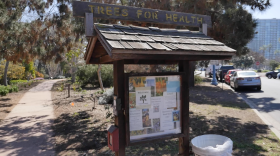A neighborhood spat in suburban San Diego is raising questions about whether Republican Assembly District 75 candidate Carl DeMaio actually resides in the district he’s seeking to represent.
DeMaio and his partner, Johnathan Hale, have a home in San Diego’s Rancho Bernardo neighborhood. Their neighbor, Roya Zamanian, claims DeMaio and Hale have engaged in an “escalating pattern of intrusive and threatening behavior,” apparently because they take umbrage with her lawn and gardening decisions. DeMaio has rejected these allegations.
It's the kind of dispute HOA boards hear all the time. But because of the parties involved and the approaching election, it's become main-stage political theater in San Diego County this week. The quarrel suggests DeMaio may not actually live in Assembly District 75 — at least, not full time.
Voice of San Diego first reported on the botanical imbroglio and Zamanian’s request for a restraining order.
KPBS dug into DeMaio’s residential history, voter registration records and campaign filings to answer an essential question: Would the candidate’s living situation disqualify him from running for the District 75 seat?
In short, the answer appears to be no. But the investigation revealed how California’s dizzying and ostensibly contradictory candidacy rules allow politicians to run in districts where they have little more than a nominal connection.
Assembly District 75 covers most of East San Diego County, including a 50-mile stretch of the U.S.-Mexico border. DeMaio, a former San Diego City Councilman who unsuccessfully ran for San Diego Mayor and multiple congressional seats, is a longtime Rancho Bernardo resident. But his Rancho Bernardo home is just outside the district’s boundaries.
So late last year, the Republican leased an apartment in Escondido and switched his voter registration address, allowing him to pull papers to run for Assembly District 75 — all within a few days.
DeMaio is facing off against fellow Republican Andrew Hayes in the general election, and the race has grown increasingly contentious.
DeMaio said on a phone call Wednesday he would only speak to KPBS off the record, which a KPBS reporter declined.
Jennifer Jacobs, a spokesperson for DeMaio, rejected any suggestion that his actions raise legal or ethical questions.
“There’s no merit to it,” she said, referring to the questions surrounding DeMaio’s residency. “Carl has multiple properties … Carl lives in the district where he is running.”
Confusing state laws
If you read California’s Constitution, it appears to offer a cut-and-dried residency requirement for candidates running for the state Legislature. It states a candidate must be “a resident of the legislative district for one year … immediately preceding the election.”
But in recent decades, that requirement has turned into a kind of zombie clause that carries no enforcement weight.
According to the Secretary of State’s office, which oversees statewide elections, former Secretary of State March Fong Eu issued an opinion in 1976 that argued the residency requirement violated the U.S. Constitution.
The opinion was challenged in 2010 in Sacramento County Superior Court, but the court similarly determined that the residency rule violated the Constitution. A state appellate court affirmed the decision.
The one-year residency requirement remains in the state Constitution. But the Secretary of State leaves the rule off its list of qualifications for Legislative candidates, calling the requirement “unenforceable.”
But what is enforceable is a rule under California’s Election Code that states candidates must be registered and qualified to vote in the district where they plan to run when they pull their nomination papers.
DeMaio barely beats deadline
DeMaio has called his Rancho Bernardo property home for many years. He listed the address on his resume as far back as 2007, according to records obtained by KPBS. He has also used the address on various campaign filings in the following years.
Last August, DeMaio sent a letter to the California Attorney General’s office regarding an election integrity initiative he had drafted. DeMaio attested that he was registered to vote at the Rancho Bernardo address.
But a few months later, DeMaio made a curious move. He switched his residency to a rental unit in Escondido — located about 800 feet inside the boundary of Assembly District 75. He traded — on paper at least — his four-bedroom, three-bathroom home for an apartment next to the interstate.
DeMaio signed the rental unit lease on Dec. 4, 2023, according to documents obtained by KPBS. That same day, he switched his voter registration to the apartment address, according to county records and a copy of DeMaio’s voter registration form reviewed by KPBS.
DeMaio was scrambling to meet a crucial deadline. He needed to pull nomination papers by Dec. 8 if he wanted to run for the Assembly District 75 seat.
With one day to spare, he announced his candidacy.
“San Diegans know I’m a fighter who is willing to speak truth to power no matter the consequence,” he said in a press release.
The question of where DeMaio spends the majority of his time remains unanswered — and will likely stay that way through the election. KPBS repeatedly asked Jacobs, DeMaio’s spokesperson, to define what she meant when she said DeMaio “lives in” Assembly District 75.
Jacobs avoided the question, reiterating that DeMaio’s candidacy has followed all applicable laws.






